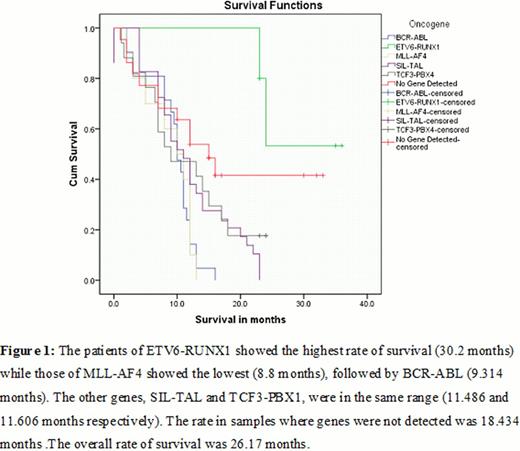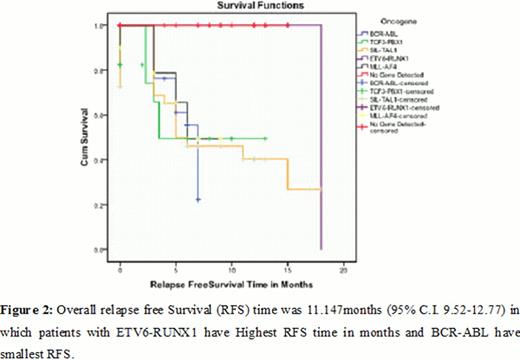Abstract
Abstract 5115
Acute lymphoblastic leukemia (ALL) is a heterogeneous lymphoid disorder with many genetic abnormalities of which fusion oncogenes (FGs) are very common with a known role in leukemogenesis (Harrison & Foroni, 2002). Although prognostic significance of FGs is well characterized in pediatric ALL, the role of FGs in adult ALL is not well established (Moorman et al., 2007).
We studied the frequency and association of five most common FGs namely BCR-ABL, MLL-AF4, ETV6-RUNX11, E2A-PBX1 and SIL-TAL1 with disease biology and treatment outcome in adult ALL. FGs were studied at diagnosis in 104 adult ALL patients using RT-PCR (Van-Dongen et al, 1999) and Interphase FISH.
FGs were found in 78. 8% (82/104) subjects (Table 1). Overall survival (OS) and relapse free survival (RFS) were 26. 17 and 11. 147 months, respectively (Figures 1–2). Patients with MLL-AF4 (12. 19%) showed an elevated total leukocyte count (TLC), prominent organomegaly, frequent central nervous system (CNS) involvement, and a poor clinical outcome (OS=8. 8 months). SIL-TAL1 (35. 36%) was associated with lymphadenopathy, frequent organomegaly, low platelets count and poor survival. Patients with BCR-ABL (20. 3%) had high TLC (p-value <0. 001), splenomegaly (p-value <0. 001), low platelets count (p-value <0. 001), poor outcome (OS=9. 3 & RFS=6. 3 months) and 10% less chances of CR as compared to BCR-ABL negative cases. ETV6-RUNX1 (4. 8 %) was mostly associated with low TLC, less common organomegaly, high CR rates and higher OS (30. 2 months), but their long term survival negatively affected by late relapses. Patients with TCF3-PBX1 (16. 3%) were associated with younger age (10/17, 59%), lower TLC (14/17, 82%), platelet count higher than 50×109/l (12/17, 71%), less common hepatomegaly (2/17, 12%), less common splenomegaly (3/17, 18%), early CR (11/17, 65%) but high relapse rate (13/17, 76. 1%) and shorter OS (11. 6 months).
High relapse rates and shorter OS despite favorable prognosis manifested by clinical features and high early CR rates in TCF3-PBX1 highlights the need for their identification at presentation and intensified treatment protocols to manage high relapse rate (Foa et al., 2003). Association of SIL-TAL1 with lymphadenopathy can help in better identification of this adult ALL subgroup at low resource centers. We found much higher frequency of TCF3-PBX1 and lower frequency of ETV6-RUNX1 than previously reported (Van Dongen et al, 1999). Although MLL-AF4 positive ALL is rarely observed in adult ALL, its frequency was 9. 7% in our adult ALL patients, which added to overall poor outcome of adult ALL in our population. Characterization of TCF3-PBX1 as poor prognostic molecular entity in our adult ALL population, low frequency of favorably prognostic ETV6-RUNX1, high frequency of poor prognostic MLL-AF4 and TCF3-PBX1 reflects ethnic and geographic differences in the biology and treatment of adult ALL (Burmeister et al., 2010). Therefore, it identifies the need for molecular testing in routine clinical settings at diagnosis and its implication in molecular prognostication and differential treatment. It also indicates the need for in-depth molecular analysis using advanced techniques and their implication in understanding the leukemogenesis and clinical management of adult ALL.
Comparison of the clinical characteristic of different FGs in ALL adult patients
| Clinical features . | BCR-ABL N=21 NO (%) . | ETV6-RUNX1 N=5 NO (%) . | MLL-AF4 N=10 NO (%) . | SIL-TAL1 N=29 NO (%) . | TCF3-PBX1 N=17 NO (%) . | Gene not detected . |
|---|---|---|---|---|---|---|
| Male | 15 (71) | 4 (80) | 7 (70) | 24 (83) | 15 (88) | 17 |
| Female | 6 (29) | 1 (20) | 3 (30) | 5 (17) | 2 (12) | 5 |
| Age | ||||||
| 16y-29 y | 4 (19) | 3 (60) | 6 (60) | 19 (65) | 10 (59) | 17 |
| 30y-59y | 13 (62) | 2 (40) | 3 (30) | 9 (31) | 6 (35) | 4 |
| ≥60y | 4 (19) | 0 | 1 (10) | 1 (3) | 1 (6) | 1 |
| WBC | ||||||
| <30,000 | 11 (52) | 4 (80) | 7 (30) | 16 (55) | 10 (58.8) | 20 |
| >30,000 | 10 (48) | 1 (20) | 3 (70) | 13 (45) | 7 (41.1) | 1 |
| Hepatomegaly | ||||||
| No | 11 (52) | 2 (40) | 5 (50) | 24 (83) | 15 (88) | 22 |
| yes | 10 (48) | 3 (60) | 5 (50) | 5 (17) | 2 (12) | 0 |
| Splenomegaly | ||||||
| No | 5 (24) | 5 (100) | 5 (50) | 21 (72) | 14 (82) | 20 |
| Yes | 16 (76) | 0 | 5 (50) | 8 (28) | 3 (18) | 2 |
| Lymphadenopathy | ||||||
| No | 3 (14) | 4 (80) | 5 (50) | 21 (21) | 2 (12) | 8 |
| yes | 18 (86) | 1 (20) | 5 (50) | 8 (28) | 15 (88) | 14 |
| Platelets | ||||||
| <50,000 | 20 (95) | 1 (20) | 9 (90) | 6 (21) | 5 (29) | 2 |
| >50,000 | 1 (5) | 4 (80) | 1 (10) | 23 (79) | 12 (71) | 20 |
| Immunophenotyping | ||||||
| T-ALL | 0 | 0 | 0 | 24 (83) | 0 | 0 |
| B-ALL | 3 (14) | 2 (40) | 2 (20) | 0 | 9 (53) | 2 |
| Unknown | 19 (90) | 3 (60) | 8 (80) | 5 (17) | 8 (47) | 20 |
| CR | ||||||
| <4 weeks | 4 (19) | 4 (80) | 6 (60) | 20 (69) | 11 (65) | 15 |
| >4 weeks | 14 (66) | 1 (20) | 2 (20) | 1 (3) | 3 (18) | 3 |
| No remission | 3 (14) | 0 | 2 (20) | 8 (28) | 3 (18) | 4 |
| Clinical features . | BCR-ABL N=21 NO (%) . | ETV6-RUNX1 N=5 NO (%) . | MLL-AF4 N=10 NO (%) . | SIL-TAL1 N=29 NO (%) . | TCF3-PBX1 N=17 NO (%) . | Gene not detected . |
|---|---|---|---|---|---|---|
| Male | 15 (71) | 4 (80) | 7 (70) | 24 (83) | 15 (88) | 17 |
| Female | 6 (29) | 1 (20) | 3 (30) | 5 (17) | 2 (12) | 5 |
| Age | ||||||
| 16y-29 y | 4 (19) | 3 (60) | 6 (60) | 19 (65) | 10 (59) | 17 |
| 30y-59y | 13 (62) | 2 (40) | 3 (30) | 9 (31) | 6 (35) | 4 |
| ≥60y | 4 (19) | 0 | 1 (10) | 1 (3) | 1 (6) | 1 |
| WBC | ||||||
| <30,000 | 11 (52) | 4 (80) | 7 (30) | 16 (55) | 10 (58.8) | 20 |
| >30,000 | 10 (48) | 1 (20) | 3 (70) | 13 (45) | 7 (41.1) | 1 |
| Hepatomegaly | ||||||
| No | 11 (52) | 2 (40) | 5 (50) | 24 (83) | 15 (88) | 22 |
| yes | 10 (48) | 3 (60) | 5 (50) | 5 (17) | 2 (12) | 0 |
| Splenomegaly | ||||||
| No | 5 (24) | 5 (100) | 5 (50) | 21 (72) | 14 (82) | 20 |
| Yes | 16 (76) | 0 | 5 (50) | 8 (28) | 3 (18) | 2 |
| Lymphadenopathy | ||||||
| No | 3 (14) | 4 (80) | 5 (50) | 21 (21) | 2 (12) | 8 |
| yes | 18 (86) | 1 (20) | 5 (50) | 8 (28) | 15 (88) | 14 |
| Platelets | ||||||
| <50,000 | 20 (95) | 1 (20) | 9 (90) | 6 (21) | 5 (29) | 2 |
| >50,000 | 1 (5) | 4 (80) | 1 (10) | 23 (79) | 12 (71) | 20 |
| Immunophenotyping | ||||||
| T-ALL | 0 | 0 | 0 | 24 (83) | 0 | 0 |
| B-ALL | 3 (14) | 2 (40) | 2 (20) | 0 | 9 (53) | 2 |
| Unknown | 19 (90) | 3 (60) | 8 (80) | 5 (17) | 8 (47) | 20 |
| CR | ||||||
| <4 weeks | 4 (19) | 4 (80) | 6 (60) | 20 (69) | 11 (65) | 15 |
| >4 weeks | 14 (66) | 1 (20) | 2 (20) | 1 (3) | 3 (18) | 3 |
| No remission | 3 (14) | 0 | 2 (20) | 8 (28) | 3 (18) | 4 |
No relevant conflicts of interest to declare.
Author notes
Asterisk with author names denotes non-ASH members.



This feature is available to Subscribers Only
Sign In or Create an Account Close Modal